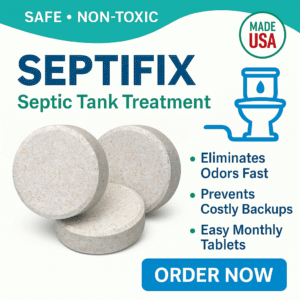Septic systems are a vital part of many homes, quietly handling wastewater out of sight. But when something goes wrong, homeowners often ask: are septic tanks covered under homeowners insurance? The answer is: sometimes. Standard homeowners insurance typically covers sudden, accidental damage—like a tree falling on your tank—but not routine wear, poor maintenance, or gradual system failure. In this guide, we’ll explain when coverage applies, what’s excluded, and highlight the best ($300+) products that help protect your septic investment and reduce the risk of costly out-of-pocket repairs.
Quick Picks: Best Products to Protect Your Septic System
- Zoeller M267 Waste-Mate Pump – Best Overall: keeps wastewater flowing and prevents pump failures that insurance may not cover.
- Polylok 24″ Septic Riser Kit with Lid – Best Budget: improves access for inspections and reduces costly emergency service calls.
- Anysun 100-FT Sewer Inspection Camera – Best Premium: lets you document septic conditions for insurance claims and early problem detection.
Buyer’s Guide: Insurance & Septic Coverage
- Covered: Sudden accidental damage, like a fallen tree crushing the tank or fire-related damage.
- Not Covered: Normal wear and tear, poor maintenance, root intrusion, or system overload.
- Drain Field Exclusion: Many policies exclude coverage for the leach field entirely, even if the tank is included.
- Endorsements: Some insurers offer septic system endorsements or service line coverage at extra cost.
- Documentation: Keeping records of maintenance and inspections strengthens claims if damage occurs.
Common Septic Issues Insurance Won’t Cover
- Sludge buildup from skipped pumping.
- Root damage from nearby trees.
- Drain field failure due to poor soil absorption.
- Damage from flushing grease, wipes, or chemicals.
How to Protect Your Septic System Financially
- Maintain regularly: Pump every 3–5 years and keep records.
- Install risers: Easier inspections reduce emergency costs and delays.
- Consider service line coverage: Some policies add septic protection for a small monthly fee.
- Inspect proactively: Use cameras to monitor sludge and damage before it escalates.
- Upgrade pumping equipment: Quality pumps like Zoeller reduce system strain and prevent failures.
Detailed Product Reviews
Zoeller M267 Waste-Mate Pump
Who it’s for: Homeowners relying on pump chambers as part of their septic system.
- Key Benefits: Cast iron build, handles 2” solids, proven reliability.
- Pros: Long lifespan, dependable, reduces emergency failures.
- Cons: Higher upfront investment, needs professional installation.
Final Verdict: A strong pump that minimizes the risk of breakdowns insurance won’t pay for.
Polylok 24″ Septic Tank Riser Kit
Who it’s for: Homeowners wanting easier access for inspections, pumping, and documenting maintenance.
- Key Benefits: Brings septic lid to grade, seals tightly, insulated lid prevents freezing.
- Pros: Affordable, improves safety, simplifies maintenance.
- Cons: Must be installed properly to fit your tank model.
Final Verdict: A simple, budget-friendly upgrade that makes long-term septic care easier and cheaper.
Anysun 100-FT Sewer Inspection Camera
Who it’s for: Homeowners who want proof of maintenance and early problem detection for insurance claims.
- Key Benefits: 100-ft cable, waterproof camera, DVR recording feature.
- Pros: Helps monitor tank and lines, provides video documentation for claims.
- Cons: Learning curve, higher upfront cost.
Final Verdict: A premium tool that adds peace of mind and supports claims in case of damage.
Comparison Table
| Product | Type | Best For | Price Link |
|---|---|---|---|
| Zoeller M267 Pump | Sewage Pump | Reliable wastewater pumping | See Price |
| Polylok 24″ Riser Kit | Septic Riser | Improved access & maintenance | See Price |
| Anysun 100-FT Camera | Inspection Camera | Monitoring & documenting system | See Price |
FAQ
1. Does homeowners insurance cover septic system replacement?
Usually not. Full replacement from wear, roots, or soil issues is considered maintenance, not an insurable event.
2. Will insurance cover septic backups?
Some policies cover water damage inside the home caused by backups, but not the septic repair itself unless endorsed.
3. Can I add septic coverage to my policy?
Yes. Some insurers offer service line or septic endorsements for an additional premium.
4. How much does septic coverage add to insurance?
Typically $50–$200 annually, depending on your insurer and state.
5. What proof do I need for a septic claim?
Maintenance records, inspection reports, and in some cases, photos or video evidence of sudden damage.
Conclusion
Septic tanks are only partially covered under homeowners insurance—usually only for sudden, accidental damage. Routine wear, poor maintenance, or drain field failure are typically excluded. That’s why it’s essential to maintain your system with products like the Zoeller M267 Pump, Polylok Riser Kit, and Anysun Inspection Camera. By combining good care with the right insurance endorsements, you’ll protect your home, your septic investment, and your peace of mind.
